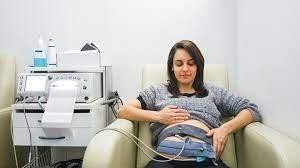A nurse is preparing to collect a blood specimen from a newborn via a heel stick. Identify the sequence of steps the nurse should follow. (Move the steps into the box on the right, placing them in the order of performance. Use all the steps.)
Confirm the newborn's identity.
Cleanse the site with an antiseptic.
Pierce the newborn's heel.
Apply gentle pressure to the site with dry gauze.
Warm the newborn's heel
The Correct Answer is A,E,B,C,D
Proper procedure for a heel stick includes:
A) Confirming the newborn's identity before any procedure. the nurse should confirm the newborn's identity by checking the identification band and asking the mother or caregiver to verify the name and date of birth.
E) The nurse should warm the newborn's heel by placing a warm compress or a heel warmer on the site for 3 to 5 minutes. This will increase blood flow and reduce pain.
B) Cleansing the site with an antiseptic to reduce the risk of infection. the nurse should cleanse the site with an antiseptic, such as alcohol or chlorhexidine, and let it air dry. The nurse should avoid using iodine, as it can interfere with some laboratory tests.
C) The nurse should pierce the newborn's heel with a sterile lancet, making sure to avoid the central area of the heel, where there are more nerves and bones. The nurse should use a single-use device that retracts automatically after use to prevent needlestick injuries.
D) The nurse should apply gentle pressure to the site with dry gauze to facilitate blood flow and collect the specimen in the appropriate container. The nurse should avoid squeezing or milking the site, as this can cause hemolysis or tissue damage.
E) The nurse should label the specimen with the newborn's name, date of birth, date and time of collection, and type of test. The nurse should also document the procedure in the newborn's chart, noting any difficulties or complications.
Nursing Test Bank
Naxlex Comprehensive Predictor Exams
Related Questions
Correct Answer is C
Explanation
A) Incorrect- Oxytocin is not typically administered during a nonstress test.
B) Incorrect- A nonstress test is used to assess fetal well-being and does not indicate Down syndrome.
C) Correct - A lateral tilt position (usually left lateral tilt) is recommended during a nonstress test to prevent compression of the vena cava and maintain proper blood flow to the uterus, which can optimize fetal heart rate monitoring.
D) Incorrect- NPO status is not typically required for a nonstress test. Nonstress tests are non-invasive and do not involve fasting.

Correct Answer is C
Explanation
A) Incorrect- Hydrocortisone ointment is not typically recommended for treating mastitis, as it might not address the underlying infection.
B) Incorrect- Wearing a well-fitting, supportive nursing bra can actually help alleviate discomfort and is not typically contraindicated in cases of mastitis.
C) Correct - Applying warm compresses to the affected breast can help reduce pain and discomfort associated with mastitis. Warmth can improve blood flow and promote milk flow.
D) Incorrect- Encouraging the client to limit oral fluid intake to decrease milk production is not a recommended approach, as maintaining proper hydration is important, especially when dealing with infection.

Whether you are a student looking to ace your exams or a practicing nurse seeking to enhance your expertise , our nursing education contents will empower you with the confidence and competence to make a difference in the lives of patients and become a respected leader in the healthcare field.
Visit Naxlex, invest in your future and unlock endless possibilities with our unparalleled nursing education contents today
Report Wrong Answer on the Current Question
Do you disagree with the answer? If yes, what is your expected answer? Explain.
Kindly be descriptive with the issue you are facing.
